Last Updated on December 29, 2021 at 5:29 pm
The worldwide crash in stock markets is a perfect launching pad for Motilal Oswal S&P 500 Index Fund. The crash can be sold as a “buying opportunity” to accumulate AUM in the NFO period (April 15th to 23rd 2020). We analyse S&P 500 returns – SIP and lump sum – to determine if it makes sense for resident Indians to invest in this fund.
Those who are interested in Motilal Oswal S&P 500 Index Fund can be classified into two: (1) those who have seen the US market grow and grow in the last few years, assume this growth will continue after a sharp recovery (some believe the recovery has already begun) and see this a buying opportunity. All they want is a slice of the profits.
Such investors can invest in this NFO. After all, their portfolios are likely to be already cluttered with such accumulated “slices” in this past. What difference – good or bad – could another slice do? Those who wish to check if it is worth the trouble can consult the graphs below.
The counter-argument here is, the US is likely to face a recession for the next couple of years. The recovery may not be as swift or as smooth as 2008 and the US markets are due for a sideways move (what goes up and all that) and if you can see cycles in the graphs below, this buying opportunity could quickly turn in to trap.
Join 32,000+ readers and get free money management solutions delivered to your inbox! Subscribe to get posts via email! (Link takes you to our email sign-up form)
🔥Want to create a complete financial plan? Learn goal-based investing? Exclusive access to our DIY tools? Increase your income with your skills? Enjoy massive discounts on our robo-advisory tool & courses! 🔥
update 19th April: Want to have a small exposure to this fund? Check out this detailed analysis before investing: This is how buying US stocks will affect your portfolio
Is this a way to diversify?
(2) those who see this as a diversification opportunity, understand that such diversification could lower overall returns, comes with risk, need not always pay off and requires disciplined rebalancing regardless of exit loads and tax.
Investors will first need to check how efficiently designed their current portfolios are and if they afford to or manage to add at least 15% to 20% of this fund. Otherwise, the benefit may not be enough (a detailed study on this coming up)
The graphs presented below may be of some use to such investors. We shall compare S& P 500 TRI(in USD), S&P 500 TRI INR, NIfty 50 and the gilt index I-BEX (I-Sec Sovereign Bond Index).
What the Indian Investor should expect from Motilal Oswal S&P 500 Index Fund
For a resident Indian, an investment in the S&P 500 index (in INR) should provide a reward commensurate with the risk and provide stability to the portfolio by lowering volatility. For efficient diversification, the S&P 500 should not move in tandem with say the Nifty 50.
We already notice that in severe events such as the one unfolding all stock markets move in the same direction and often is joined in by bond markets as well! Therefore those looking to diversify must keep this in mind.
The I-BEX gilt index is used to measure risk premium. The resident Indian’s return from S&P 500 TRI INR should be well above the return from the gilt index otherwise it does not justify the risk (both are taxed in the same way).
Why there is no need to hurry
Before we begin the analysis, there is no flaming hurry to invest in Motilal Oswal S&P 500 Index Fund during the NFO period. The expense ratio is unknown. The AUM is unknown. The tracking error is unknown.
This index fund is expected to be less expensive than ICICI US Bluechip or the Franklin US Feeder fund but that benefit depends on the tracking error. This S&P 500 index fund is a much more useful offering from Motilal Oswal than its small cap index fund or mid cap index fund (or even its Nifty 500 index fund).
However, the fund should still perform. Those who worry that they would miss the buying opportunity by waiting are playing right into the hands of the AMCs selling campaign. There is no need to act like this is the only money we would be investing and now is the only time we would be investing.
The crucial role played by the exchange rate
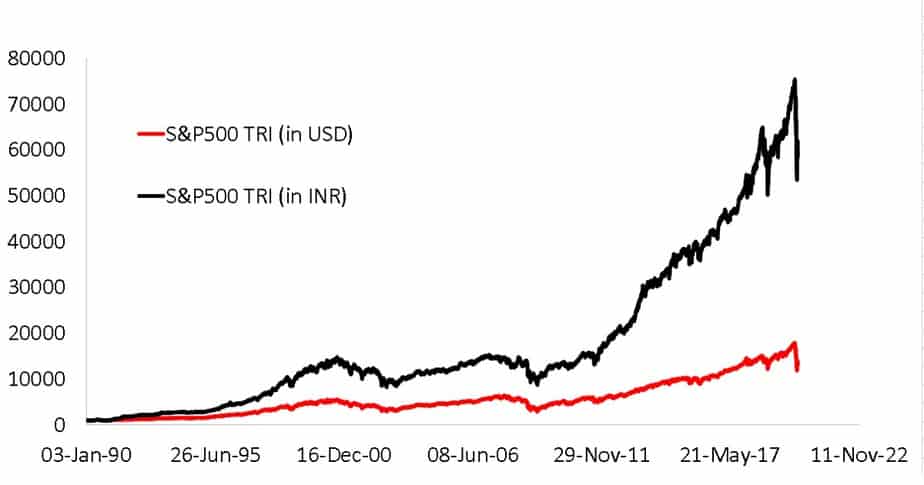
When one sees the way in which the USD to INR exchange rate has influenced the movement of the S&P 500 it seems extremely tempting to buy. However, we must recognise that this is an optical illusion. What we see above the return of a single investment made in Jan 1990 realised in April 2020.
As noted before – Review: Motilal Oswal Nasdaq 100 Fund of Fund – the USD INR exchange over the long term behaves like a bond yielding 5-6% returns. It is reasonable to expect this in the foreseeable future but may not deliver each time and may result in a higher return for S& P 500 INR over S&P 500 USD.
S& P 500 vs Nifty 50
Let us first check how correlated Nifty 50 is with S&P 500. Every possible 5, 10 and 15-year returns (lump sum) is shown below.
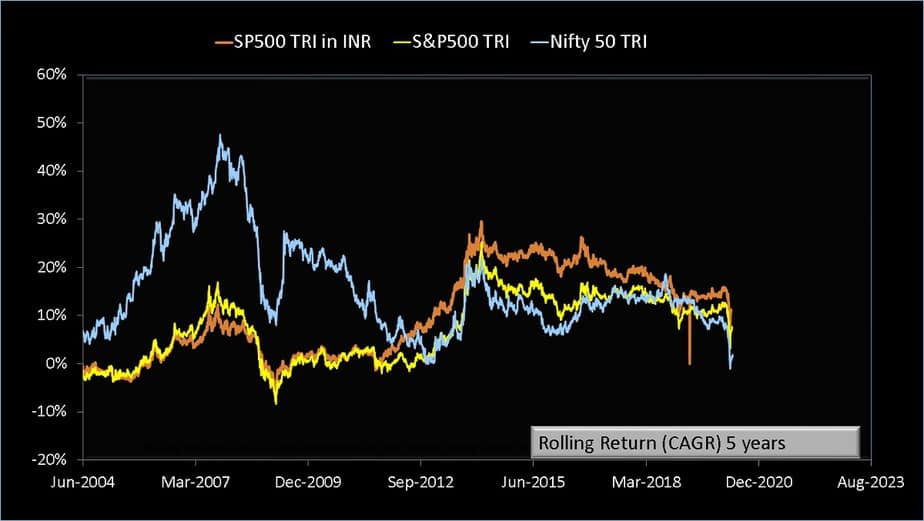
Notice that 5-year NIfty returns have dramatically dropped below S&P 500 since 2012. The roles could reverse going forward and this is something that potential investors in Motilal Oswal S&P 500 Index Fund should keep in mind. Would they still talk about the “benefits of international diversification” when the fund does not fire?
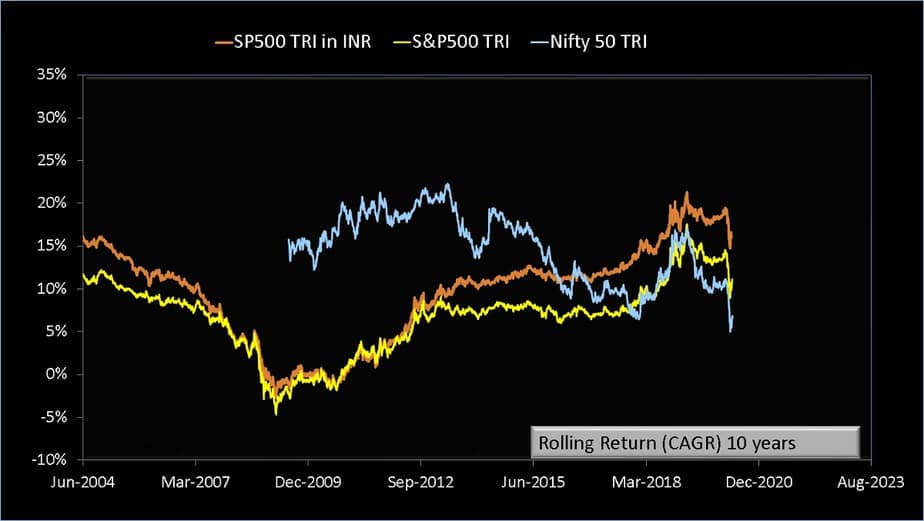
The situation is similar for 10-year data but opposite for 15-year data.
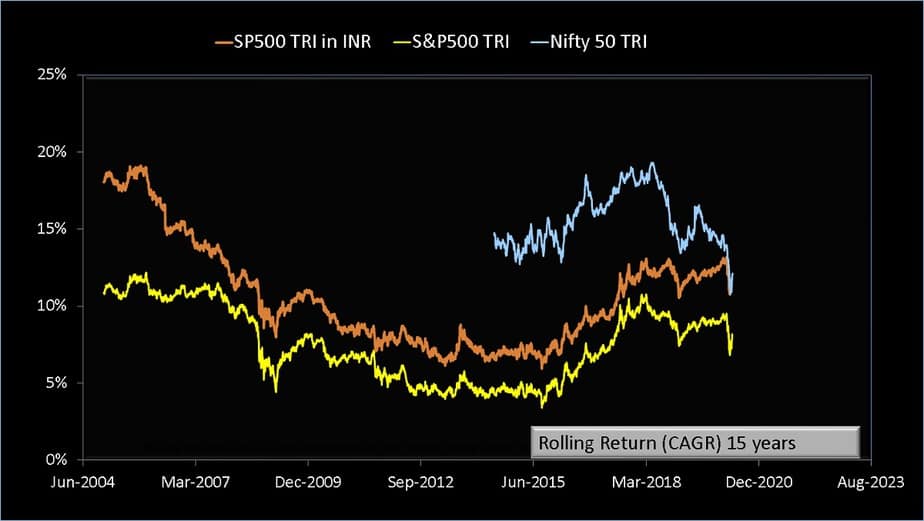
It is reasonably justified to use S&P 500 in addition to the NIfty 50 (= Indian equity) to diversify portfolio risk. However, one will need to get rid of recency bias and appreciate that the S&P 500 could underperform in future and still fulfil its diversification role.
Notice that lump sum returns of S&P 500 INR is not always greater than S&P 500 USD. This is because the exchange rate does not always increase linearly.
S & P 500 vs I-Sec Sovereign Bond Index (lump sum returns)
For an invest in S&P 500 (INR) to make sense, the orange line in the graphs below should be well above the green line. The returns from the USD INR exchange rate is also shown.
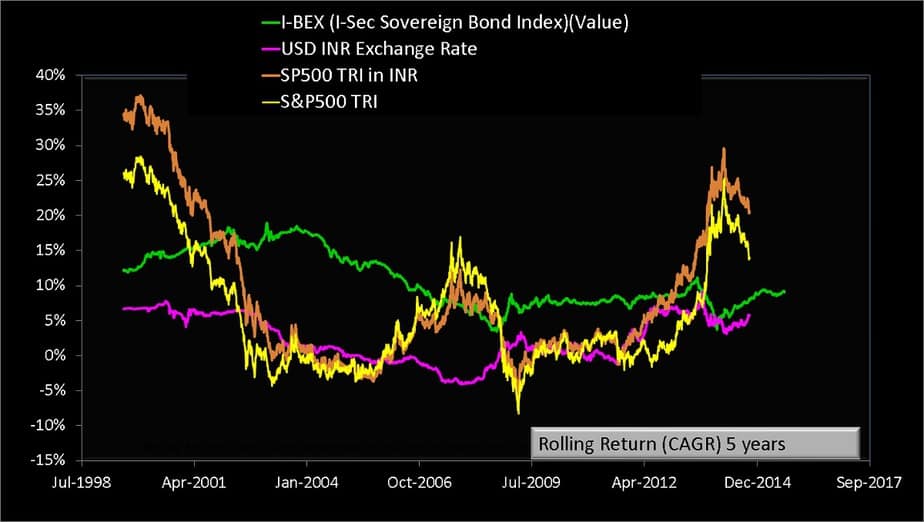
For those who can spot a cycle below, S&P 500 return might head lower in future. Maybe there is no cycle and maybe returns could improve. No one knows.
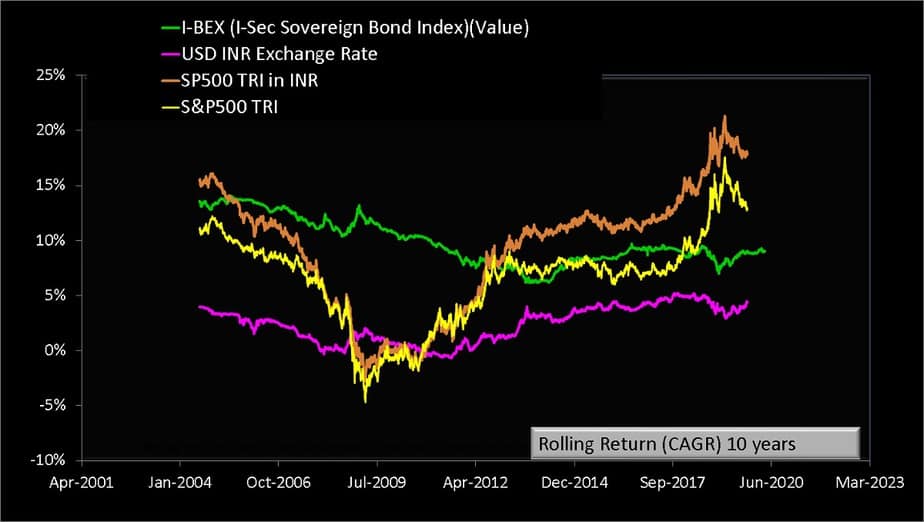
The risk premium offered by S&P 500 INR is a recent phenomenon as can be observed from both 10 and 15-year data.
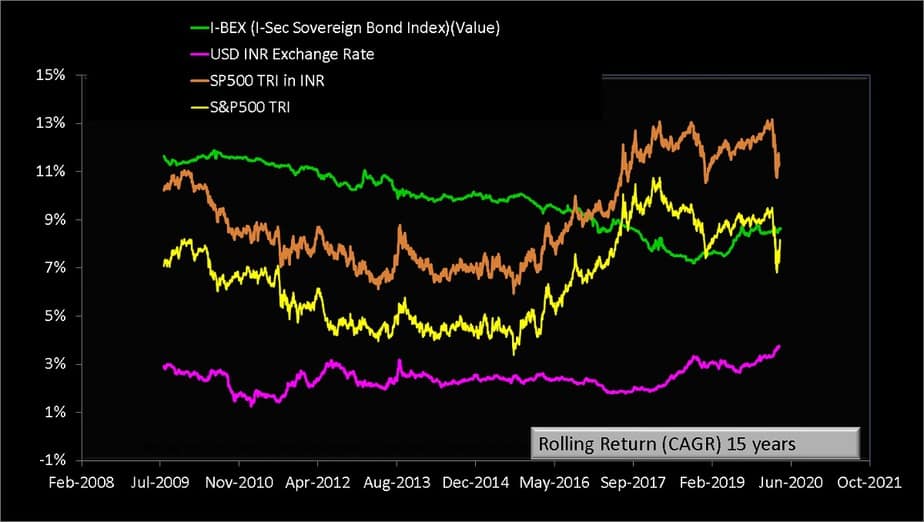
Twenty-year data (investment window ending between Jun 2014 and April 2020) does not paint a promising picture though. Even if the green line heads downward, the orange could move down faster!
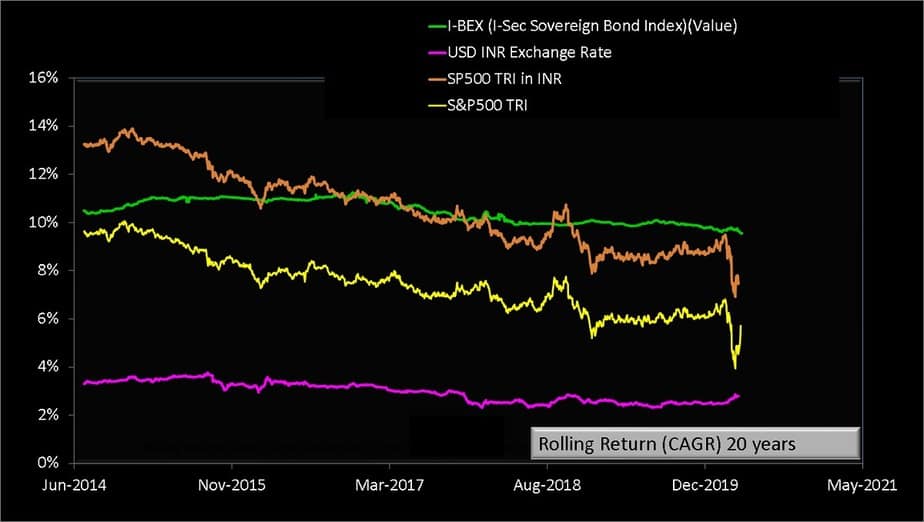
S & P 500 vs I-Sec Sovereign Bond Index (sip returns)
We look at rolling SIp returns and now the red dots should be above the grey dots to justify the risk. Notice the 0% data points. These are SIP windows with negative or indeterminate returns.




Considerations
- S&P 500 (INR) has offered a risk premium only in the last decade. The tide may reverse.
- Fear of future low returns is heightened by the fear of an extended recession in the US.
- Investors who enter now must be prepared for at least a few years of poor returns
- They certainly should not expect a recovery similar to what occurred after 2008. The circumstances are quite different
- The exposure should be significant for efficient diversification.
- The investor must learn how to quantify diversification benefit or would only end up with portfolio clutter
- Piece-meal analysis of returns are not of much use: “my investment in a US international fund over the last 5 years gave me 20%” kind of statements are of little use. How was the investment made wrt to the entire portfolio is what determines actual gains.
Those who appreciate risk and understand how to measure benefits can consider investing in Motilal Oswal S&P 500 Index Fund. Long-term investors can wait and watch for a while before investing. Those hoping for a quick recovery (may not be the case!) and wish to book profit (taxable as per slab) soon after, may invest in the NFO period.
🔥Enjoy massive discounts on our courses, robo-advisory tool and exclusive investor circle! 🔥& join our community of 7000+ users!
Use our Robo-advisory Tool for a start-to-finish financial plan! ⇐ More than 2,500 investors and advisors use this!
Track your mutual funds and stock investments with this Google Sheet!
We also publish monthly equity mutual funds, debt and hybrid mutual funds, index funds and ETF screeners and momentum, low-volatility stock screeners.





- Do you have a comment about the above article? Reach out to us on Twitter: @freefincal or @pattufreefincal
- Have a question? Subscribe to our newsletter using the form below.
- Hit 'reply' to any email from us! We do not offer personalized investment advice. We can write a detailed article without mentioning your name if you have a generic question.
Join 32,000+ readers and get free money management solutions delivered to your inbox! Subscribe to get posts via email! (Link takes you to our email sign-up form)
About The Author
 Dr M. Pattabiraman(PhD) is the founder, managing editor and primary author of freefincal. He is an associate professor at the Indian Institute of Technology, Madras. He has over ten years of experience publishing news analysis, research and financial product development. Connect with him via Twitter(X), Linkedin, or YouTube. Pattabiraman has co-authored three print books: (1) You can be rich too with goal-based investing (CNBC TV18) for DIY investors. (2) Gamechanger for young earners. (3) Chinchu Gets a Superpower! for kids. He has also written seven other free e-books on various money management topics. He is a patron and co-founder of “Fee-only India,” an organisation promoting unbiased, commission-free investment advice.
Dr M. Pattabiraman(PhD) is the founder, managing editor and primary author of freefincal. He is an associate professor at the Indian Institute of Technology, Madras. He has over ten years of experience publishing news analysis, research and financial product development. Connect with him via Twitter(X), Linkedin, or YouTube. Pattabiraman has co-authored three print books: (1) You can be rich too with goal-based investing (CNBC TV18) for DIY investors. (2) Gamechanger for young earners. (3) Chinchu Gets a Superpower! for kids. He has also written seven other free e-books on various money management topics. He is a patron and co-founder of “Fee-only India,” an organisation promoting unbiased, commission-free investment advice.Our flagship course! Learn to manage your portfolio like a pro to achieve your goals regardless of market conditions! ⇐ More than 3,000 investors and advisors are part of our exclusive community! Get clarity on how to plan for your goals and achieve the necessary corpus no matter the market condition is!! Watch the first lecture for free! One-time payment! No recurring fees! Life-long access to videos! Reduce fear, uncertainty and doubt while investing! Learn how to plan for your goals before and after retirement with confidence.
Our new course! Increase your income by getting people to pay for your skills! ⇐ More than 700 salaried employees, entrepreneurs and financial advisors are part of our exclusive community! Learn how to get people to pay for your skills! Whether you are a professional or small business owner who wants more clients via online visibility or a salaried person wanting a side income or passive income, we will show you how to achieve this by showcasing your skills and building a community that trusts and pays you! (watch 1st lecture for free). One-time payment! No recurring fees! Life-long access to videos!
Our new book for kids: “Chinchu Gets a Superpower!” is now available!


Must-read book even for adults! This is something that every parent should teach their kids right from their young age. The importance of money management and decision making based on their wants and needs. Very nicely written in simple terms. - Arun.Buy the book: Chinchu gets a superpower for your child!
How to profit from content writing: Our new ebook is for those interested in getting side income via content writing. It is available at a 50% discount for Rs. 500 only!
Do you want to check if the market is overvalued or undervalued? Use our market valuation tool (it will work with any index!), or get the Tactical Buy/Sell timing tool!
We publish monthly mutual fund screeners and momentum, low-volatility stock screeners.
About freefincal & its content policy. Freefincal is a News Media Organization dedicated to providing original analysis, reports, reviews and insights on mutual funds, stocks, investing, retirement and personal finance developments. We do so without conflict of interest and bias. Follow us on Google News. Freefincal serves more than three million readers a year (5 million page views) with articles based only on factual information and detailed analysis by its authors. All statements made will be verified with credible and knowledgeable sources before publication. Freefincal does not publish paid articles, promotions, PR, satire or opinions without data. All opinions will be inferences backed by verifiable, reproducible evidence/data. Contact information: To get in touch, use this contact form. (Sponsored posts or paid collaborations will not be entertained.)
Connect with us on social media
- Twitter @freefincal
- Subscribe to our YouTube Videos
- Posts feed via Feedburner.
Our publications
You Can Be Rich Too with Goal-Based Investing
 Published by CNBC TV18, this book is meant to help you ask the right questions and seek the correct answers, and since it comes with nine online calculators, you can also create custom solutions for your lifestyle! Get it now.
Published by CNBC TV18, this book is meant to help you ask the right questions and seek the correct answers, and since it comes with nine online calculators, you can also create custom solutions for your lifestyle! Get it now.Gamechanger: Forget Startups, Join Corporate & Still Live the Rich Life You Want
 This book is meant for young earners to get their basics right from day one! It will also help you travel to exotic places at a low cost! Get it or gift it to a young earner.
This book is meant for young earners to get their basics right from day one! It will also help you travel to exotic places at a low cost! Get it or gift it to a young earner.Your Ultimate Guide to Travel
 This is an in-depth dive into vacation planning, finding cheap flights, budget accommodation, what to do when travelling, and how travelling slowly is better financially and psychologically, with links to the web pages and hand-holding at every step. Get the pdf for Rs 300 (instant download)
This is an in-depth dive into vacation planning, finding cheap flights, budget accommodation, what to do when travelling, and how travelling slowly is better financially and psychologically, with links to the web pages and hand-holding at every step. Get the pdf for Rs 300 (instant download)